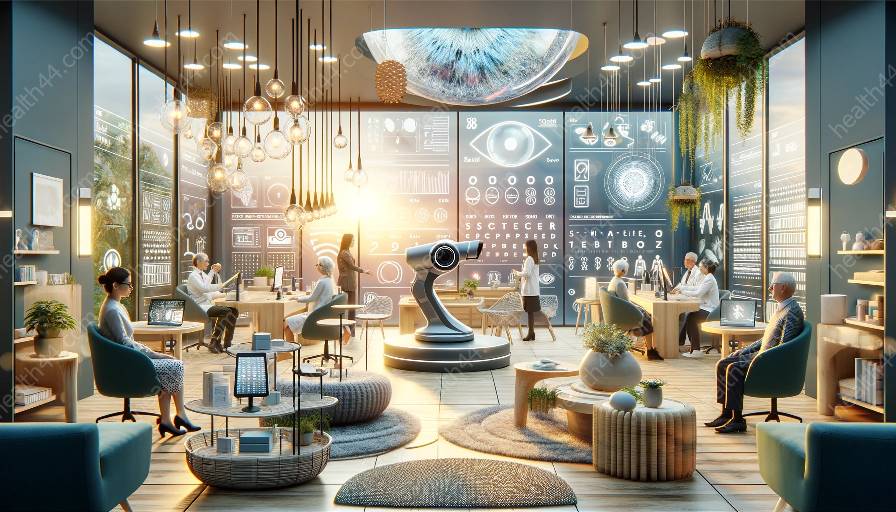Assistive technology has revolutionized the field of vision rehabilitation, offering incredible opportunities for individuals with vision impairments to lead more independent, productive lives. This comprehensive guide explores the efficacy of assistive technology in vision rehabilitation programs, shedding light on the latest technological innovations and their impact on individuals with visual impairment.
The Role of Assistive Technology in Vision Rehabilitation
Vision rehabilitation encompasses a range of techniques and tools designed to enhance the daily functioning and quality of life for individuals with vision impairments. Assistive technology plays a fundamental role in vision rehabilitation by providing innovative solutions that enable individuals to perform tasks and activities that may otherwise have been challenging or impossible.
Enhancing Access to Information and Communication
One of the primary areas in which assistive technology has a profound impact is in enhancing access to information and communication for individuals with vision impairments. With the advent of advanced screen reader software, individuals can access digital content, including websites, documents, and emails, through synthesized speech or braille displays. Furthermore, optical character recognition (OCR) technology allows printed materials to be converted into accessible digital formats, further expanding the availability of information to individuals with visual impairments.
Facilitating Independent Living and Mobility
Assistive technology also significantly contributes to promoting independent living and enhancing mobility for individuals with visual impairments. Modern mobility aids, such as electronic travel aids (ETAs) and GPS navigation systems specifically designed for individuals with visual impairments, allow for greater autonomy when navigating both indoor and outdoor environments. Additionally, advancements in smart home technology provide individuals with visual impairments the ability to control various aspects of their living environment, from adjusting lighting and temperature to accessing entertainment and communication devices, thus fostering greater independence and self-sufficiency.
Latest Innovations in Assistive Technology for Vision Rehabilitation
The rapid evolution of technology continues to drive groundbreaking innovations in assistive technology for vision rehabilitation. One notable advancement is the development of wearable devices that utilize computer vision and artificial intelligence to provide real-time object recognition and spatial awareness to individuals with visual impairments. These devices offer valuable assistance in identifying and navigating physical environments, significantly increasing the level of independence and freedom for users.
Integration of Artificial Intelligence and Machine Learning
Artificial intelligence and machine learning technologies are being integrated into assistive devices to enhance their capabilities, enabling personalized assistance based on the specific needs and preferences of individuals with visual impairments. By learning and adapting to the user's behavior and surroundings, these technologies can provide tailored support to optimize the individual's daily experiences and foster greater autonomy.
Advancements in Haptic Feedback Technology
Haptic feedback technology, which simulates the sense of touch through vibrations or other tactile sensations, has seen significant advancements in its application within assistive devices for individuals with visual impairments. These advancements enable individuals to receive tactile feedback and spatial cues, aiding in the interpretation of their immediate environment and enhancing their spatial awareness. This has profound implications for increasing safety and confidence in navigating various settings, including crowded public spaces and unfamiliar surroundings.
Impact of Assistive Technology on Quality of Life
The integration of assistive technology within vision rehabilitation programs has had a transformative impact on the quality of life for individuals with vision impairments. By empowering individuals to access information, navigate their environment, and engage in daily activities more independently, assistive technology has opened up new opportunities and possibilities, fostering greater inclusion and participation in various aspects of life.
Promoting Education and Employment Opportunities
With the support of assistive technology, individuals with visual impairments are better equipped to pursue education and employment opportunities. Accessible technologies, such as screen readers, braille displays, and magnification software, enable individuals to engage with digital content, participate in online learning, and access job-related materials, thereby breaking down barriers to education and employment.
Enhancing Social Connectivity and Participation
Assistive technology also plays a pivotal role in facilitating social connectivity and participation for individuals with visual impairments. Through accessible communication devices and adaptive software, individuals can engage in online social networks, access audio-described media, and participate in virtual community events, promoting a sense of connection and belonging within society.
Future Opportunities and Challenges
As technology continues to advance, the future of assistive technology in vision rehabilitation holds great promise, offering opportunities to further enhance the efficacy of rehabilitation programs and improve the lives of individuals with vision impairments. However, challenges such as affordability, accessibility, and the need for continuous innovation and user-centered design must be addressed to ensure that assistive technology continues to meet the diverse and evolving needs of individuals with visual impairments.
Addressing Affordability and Accessibility
Ensuring the affordability and widespread accessibility of assistive technology is essential in maximizing its impact in vision rehabilitation programs. Efforts to reduce technological barriers, promote universal design principles, and increase availability of funding and resources are vital in ensuring that individuals with visual impairments can access the assistive technologies they need to thrive.
Embracing User-Centered Design and Collaboration
Future advancements in assistive technology should prioritize user-centered design principles and collaboration with individuals with visual impairments, rehabilitation professionals, and technology developers. By actively involving end-users in the development process, assistive technologies can be tailored to better meet the specific needs, preferences, and capabilities of individuals, ultimately enhancing their efficacy and usability.
Driving Continued Innovation and Advocacy
Advocacy efforts and investment in research and development are essential in driving continued innovation in assistive technology for vision rehabilitation. By promoting the exploration of cutting-edge technologies, fostering interdisciplinary collaborations, and advocating for policies that support the development and dissemination of assistive technologies, we can pave the way for a future where individuals with visual impairments have access to even more effective and empowering assistive solutions.





















